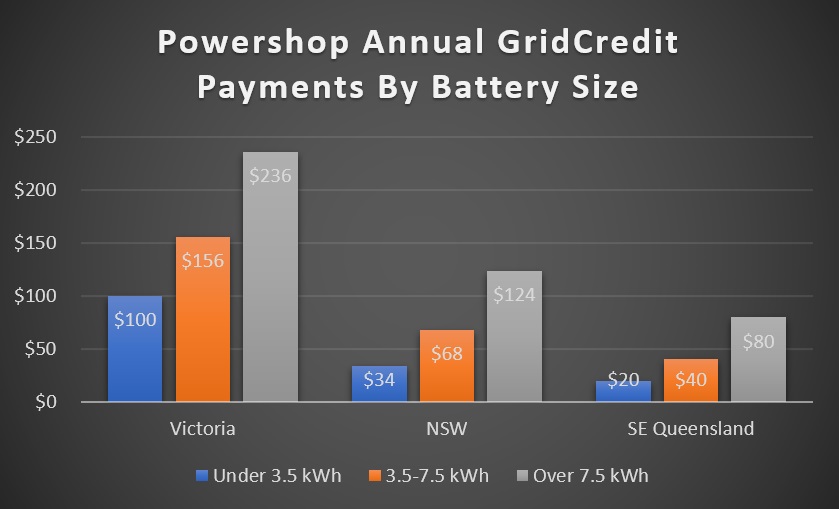
Powershop Reveals Dollar Value Of Reposit Payments For Exporting Battery Power To Grid During ‘Critical Peaks’
Reposit is a smart controller that helps households make more effective use of battery systems. One advantage Reposit provides is during certain — very limited — periods of time, you can be paid $1 for each kilowatt-hour of electricity your battery exports to the grid. Reposit calls these payments GridCredits.
Getting paid for having a battery system is cool. The problem is, in the past, it wasn’t possible to know how much you’d actually get. This is because Reposit wouldn’t tell you. While they couldn’t predict future payment amounts exactly, because they depend on events in the wholesale electricity market, I firmly believe that they could have made a reasonable prediction. But they didn’t do this.
If they didn’t like making predictions, what they could have done is provide information on how much typical Reposit enabled battery systems had earned in the past. But they didn’t do this either. I know because I asked them and they didn’t tell me. Of course they didn’t not tell me straight away. Oh no, that would have been too easy! Instead they kept me waiting for three weeks and then didn’t tell me. If you want to read about this experience and Reposit in general, I wrote about it here.
But a week ago I learned about a miracle. Thanks to Reposit’s partnership with the electricity retailer Powershop, if you live in Victoria, NSW, or South East Queensland, you can know exactly how much you will receive in GridCredits in advance. Not only will you know how much, but it will be credited to your electricity account quarterly. The annual GridCredit payments for a Reposit equipped battery system with 3.5 to 7.5 kilowatt-hours of storage are:
- Victoria: $156 a year.
- New South Wales: $68 a year.
- South East Queensland: $40 a year.
As you can see, it’s not a huge amount of money, especially if you’re a Queenslander. But now people can see how much they will be paid for GridCredits with Powershop1, it helps them to make an informed decision about whether or not buying a Reposit system is a good idea for them, so I think this step is great news. But it only helps and doesn’t remove all the uncertainty, as the payments will change from year to year.
More Battery Means More Money
The larger your battery system the more payment you will receive. Powershop recognizes three battery sizes:
- Small — under 3.5 kilowatt-hours
- Medium — 3.5 to 7.5 kilowatt-hours
- Large — Over 7.5 kilowatt-hours
Payments provided for 2018 are as follows:

Powershop only appears to look at the storage capacity and not the power output of a system. They also don’t consider battery degradation, so Powershop becomes a more attractive option as batteries age.
VIC, NSW & SE QLD Only
Currently Powershop only operates Victoria, New South Wales, and South East Queensland. If you live in South Australia and want to be paid for providing power to the grid through Reposit you can use Diamond Energy to get GridCredits, but you won’t know how much you will get up front. Currently Diamond Energy and Powershop are your only options for electricity retailers if you want to receive grid credits outside of the ACT. If you use Diamond Energy, you will presumably receive around the same amount as Powershop offers — maybe more or maybe less. So your choice may depend on how lucky you feel.
The ACT Is One Big Reposit Party
While the ACT is technically inside NSW, Powershop does not operate there. But Reposit has created a virtual power plant in Canberra and everyone with Reposit can receive payment for providing battery power to the grid regardless of who their electricity retailer is. You won’t be paid in advance as with Powershop, but not having to worry about changing your electricity retailer is an advantage.
Reasons For Regional Differences
There’s a huge difference between states in the amount of GridCredits Powershop offers. South East Queenslanders with a “medium” sized battery get $40 a year while medium sized Victorians receive almost 4 times as much. The difference is due to the amount of volatility in state wholesale electricity markets. The closure of Victoria’s Hazelwood Power Station and high natural gas prices have resulted in many periods of high wholesale electricity prices in that state compared to Queensland, which still has an oversupply of generating capacity and has benefited from rapidly expanding rooftop solar helping to keep a lid on daytime wholesale electricity prices.
The amount of volatility in Victoria will decline as a large amount of renewable generating capacity is built over the next 2 years and also due to increasing battery storage capacity. As a result GridCredit payments will decrease. The next large power station scheduled for closure is Liddell in 2022 in NSW and this is likely to result in another round of wholesale price volatility and payment increases.
Payments In SA May Be Similar To VIC
Like Victoria, South Australia has a lot of wholesale electricity price volatility. While Powershop is not available there, Diamond Energy is and if you are wondering how much you can expect to receive in GridCredits in that state, it may be similar to what Victorians are currently being paid by Powershop.
Electricity Market Changes May Improve Future Payments
The National Electricity Market, which covers the eastern states and South Australia, has 5 minute dispatch prices which are averaged over 30 minutes to determine the wholesale electricity spot price. This system is called 30 minute settlement. On the first of July 2021, this will change so the 5 minute periods will determine spot prices without averaging. This is called 5 minute settlement and will increase the amount of money that can by made using battery systems to sell power to the grid.
Unfortunately, since people using Reposit are only paid a flat rate of $1 per kilowatt-hour provided and not the actual wholesale price of electricity, which can go as high as $14.20 per kilowatt-hour, so they may not actually make much more money from this change. But this is still a few years away and Reposit may have changed the way it compensates people by then.
[Update: I originally wrote that wholesale prices can exceed $20 per kilowatt-hour but that is not correct.]
Powershop Clears The Air
Thanks to Powershop people can know in advance how much they’ll receive for battery power they provide to the grid and this makes it easier for them to decide if getting Reposit is worthwhile. But as these payments are not the only advantage Reposit provides, other factors will need to be taken into account and I may look into them in a future article.
Last time I checked, a Reposit battery controller cost about $1000 to buy and install for a home with single phase power. But if you have had a Reposit installed lately, let me know how much it cost you and I’ll use that real world data to estimate how much people are likely to save — or lose — by installing a Reposit smart controller in different parts of Australia.
Footnotes
- Or how much they are likely to be paid for GridCredits with Diamond Energy, their only other electricity retailer partner ↩

 RSS - Posts
RSS - Posts



Hi,
I looked into Reposit, & their product is good. It does require some questions about the unit being permanently connected to the web, so requires security updates that Reposit must perform. (So questions of time to implement these upgrades, & the risk of hackers in the interim: much like a Microsoft computer!)
There is no rocket science in the actual unit. The complexity is in the Australian certification. (I would love to see an open source device similar to the Reposit box).
At $40/yr for Qld, it would not pay for itself: the box costs something like $750 retail + installation, so do the sums!
So if I read this right, it will cost me about $1,000 to install a system that will return me $124 a year in NSW. Working on an average of 8 kwh a day from my 10kw battery exported to the grid I get a return of 4.25 cents a kwh for my exported power. That will only take me a bit over 8 years to get my $1,000 back. But the really good news is I don’t get to use those 8kwh of power during peak and shoulder which saves me 35 or 36 cents a kwh. That would only save me $1022 a year meaning getting this system would cost me $898 a year. Do they think we are brain dead morons?
Each Reposit GridCredit is worth $1 so in NSW you can export to export somewhere around 124 kilowatt-hours from your battery to the grid over a year. If this turned out to be the average each year and the Reposit controller was $1,000 to buy and install then it would have a simple payback period of about 8 years ignoring the wear and tear on your battery and around 10 years if you value each kilowatt-hour of storage you don’t use for yourself at around 20 cents.
But Reposit provides advantages other than payments for providing battery power to the grid but putting dollar figures on them would be tricky and so working out the return on installing Reposit will have to wait until I have time to work it out.
Wholesale market is capped at 13k/MWh, 13/kWh, not 20. Also, most of the value from the Reposit system currently comes from optimised self consumption.
Let me check what I’ve written… Oh yes, I think that would be the 5 minute dispatch price which can go over $20 and not the wholesale price. Thank you for pointing that out, I will correct it.
I looked at Reposit when I upgraded (replaced) my Solar system last year and added a Tesla Powerwall 2 battery. Had to remove them from my plans as they are not compatible with the Powerwall 2 batteries as there is no way to locally interface with them which is a requirement.